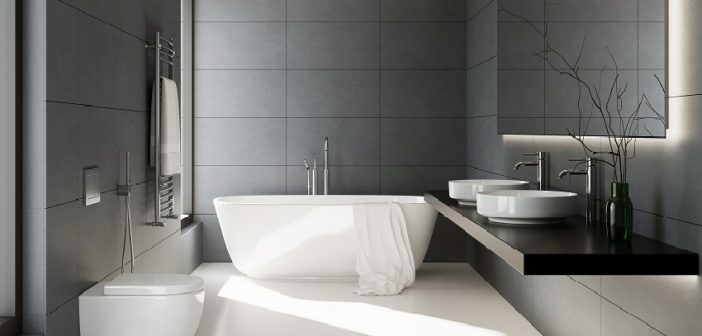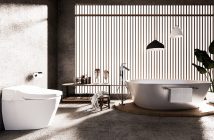While we might spend lots of time picking out the perfect bathroom suite and tiles and choosing the best layout, we don’t tend to take so much time over the lighting. But how you light the space can make a big difference to how your new bathroom looks and feels as well as how it functions. While there are no hard and fast rules in terms of style, there are some must-follow rules for how they’re lit. Here’s what you need to know.
Don’t stick with one light
One light may be inadequate for lighting a bathroom safely. It may prevent you from being able to see what you’re doing, unless you’re close enough to it. Plus, if one light doesn’t cover the whole space, it may create dark corners.
It also doesn’t offer any flexibility. That means you can’t control the brightness or atmosphere in your bathroom.
Use an electrician
Electricity and water don’t mix. For that reason, you need an electrician to carry out your lighting installation. Not only will they make sure that all the wiring is safe and to standard, but they’ll also make sure that the right types of light fittings are used in the right parts of the bathroom. If you’re unsure of whether the lights you want are suitable, they should be able to advise you.
Pick the right type of lighting
What type of light you need depends on what zone you’re putting it in. Zone 0 is considered the areas that are immersed in water, such as inside the bath and the floor inside a shower cubicle. Zone 1 is the area directly above this and zone 2 is the space that closely surrounds your bath and shower. So, for instance, the area just outside the shower cubicle. It also includes the area surrounding the sink. In each zone, there’s a minimum Ingress Protection (IP) rating that your lighting must have. For zone 0 it’s IP67, for zone 1 and zone 2 it’s IP44. However, it’s often better to go with higher ratings for zone 1 lighting.
Make lighting part of your bathroom design plan
It’s hard to add in additional lighting points after the bathroom has been fitted. So, it’s important to factor your lighting in with the rest of your bathroom’s plans. Take some time to work out what type of lights will work best and where.
Knowing what lighting and controls you want will help to determine how they need to be wired. For instance, will they all on one circuit or on separate circuits to enable you to operate them individually? This might be handy if you don’t need all the lights on at once. You’ll be able to tailor the lighting to specific tasks, such as showering or applying make-up in the mirror.
By integrating lighting into your bathroom design, you’ll also be able to plan in extras such as motion sensors. These will enable you to turn lights on automatically – which could be really handy at night.
It matters where you put your switches
In most cases, the light switches for your bathroom should be just outside the door for safety reasons. But this also means they’re handily placed for turning lights on and off as you enter and leave the bathroom. You can put a pullcord switch inside the bathroom but this can ruin the look of your bathroom and it makes it hard to control multiple lights. So, you could be limiting your options.
But you don’t need to stick to manual switches
Implementing smart controls means you can use an app, remote control or even your voice to operate your lighting. As well as on and off, you can use it to control the brightness of your bulbs. This means it’s easy to avoid eye strain first thing in the morning and enables you to dim the lights after you get in the bath. So, it’s easier to enjoy a stress-busting soak.
Use pendants and downlights carefully
A tight grid of downlights might help to eliminate dark corners but it isn’t always the best solution for bathroom lighting. It’s not a targeted approach. So, you may not end up with lights focused on the prime spots, such as above the bath, shower and sink. And having lots of lights in the ceiling won’t look great if you’re aiming for a clean-lined bathroom.
If you are using downlights, don’t overdo the number and don’t be afraid to move them out of the standard grid formation to improve their effectiveness.
Other lighting features such as pendants and chandeliers need the same level of caution. You don’t want lights to come down too low, as this can be dangerous. So, they only really work with high ceilings. And you need to make sure that any lighting you use is suitable for use in a bathroom and in the zone you want it to hang.
Don’t choose style over durability
Although a light fitting might look really chic, it’s important not to choose style over durability. Due to the moisture, metallics can rust or corrode in bathrooms. Although this can give you a rustic or aged look if you use brass, it can simply make your bathroom look shabby very quickly. So, make sure you choose high-quality fittings and that delicate finishes come with protective coatings.





Great tips for lighting a bathroom! I especially appreciate the advice on balancing style with durability and making sure lighting is functional for each zone.
Great article highlighting the importance of proper lighting in the bathroom. In addition to lighting, I would advise you to pay attention to your choice of bathroom furniture and accessories, as this also plays a key role in creating a comfortable and functional environment. For example, I recently came across an interesting website Custom Craft, where you can order unique furniture made to individual sizes and designs.
Such pieces are especially useful for small spaces or for those who want to create a custom interior. The site https://customcraftua.com/ offers a variety of options, including cabinets, shelves, and even special solutions for complex spaces. This is the perfect way to take into account all the nuances – from style to practicality.
By the way, the combination of the right lighting and individually selected furniture is the key to success in creating a really cozy and functional bathroom. For example, light reflected from furniture or mirrors can visually increase the space, and thoughtful shelves will help to keep order. If you haven’t thought about custom solutions yet, I recommend taking a look – it really inspires new ideas!
It is important to make informed decisions when you play at Boombet Casino, which allows people to play their favorite games very successfully, after a short registration you can get very good bonuses that will allow you to get started quickly. And although this site is really very friendly, it still depends on your attention and caution
If you are interested in games in New Zealand, then I definitely recommend trying to play in – Mr Fortune Casino, I recommend trying to play here for everyone who is interested in online games as for me it is generally the best site to play onayon, I recommend that everyone finds an interesting game right here, it’s really something with something!
Such a fascinating article on a lovely day like today; thank you for your efforts in creating such a beneficial article.